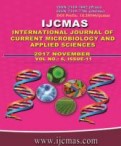


 National Academy of Agricultural Sciences (NAAS)
National Academy of Agricultural Sciences (NAAS)

|
PRINT ISSN : 2319-7692
Online ISSN : 2319-7706 Issues : 12 per year Publisher : Excellent Publishers Email : editorijcmas@gmail.com / submit@ijcmas.com Editor-in-chief: Dr.M.Prakash Index Copernicus ICV 2018: 95.39 NAAS RATING 2020: 5.38 |
The main aim of this study to isolate and identify the fungi causing dermatophytosis. Also this study of dermatophytosis was carried out in the Department of Microbiology, KLE’S Dr. PrabhakarKore Hospital and Medical Research Centre Belgaum, over a Period of one year.All skin, hair and nail samples from clinically suspected cases of dermatophytosis were included in the study.The specimens collected were inoculated on to Sabourauds Dextrose agar containing Chloramphenicol and Cycloheximide irrespective of demonstration of fungal elements on KOH mount.The isolates were inoculated on potato dextrose agar for better conidiation. Out of 100 cases included in our study male preponderance of 73 (73%) cases was seen. 27 (27%) were females. Incidence of Dermatophytosis was high in males and male to female ratio of 2.7:1.Tineacruris was the most common clinical type of dermatophytosis with incidence of 32. 37 samples were KOH negative and 63 samples were KOH positive. Out of 63 isolates of dermatophytes in our study T.rubrum was the most common dermatophyte. Dermatophytosis is the most common type of cutaneous fungal infection.The incidence of Dermatophytosis is increasing in India due to widespread and indiscriminate use of corticosteroids and antifungal agents without appropriate microbiological investigations. Dermatophytes isolated included predominately Trichophytonspecies, of which T.rubrumwas the commonest dermatophyte isolated. T.mentagrophytes, T.tonsurans, M.gypseumwere other isolates from clinical samples.
 |
 |
 |
 |
 |